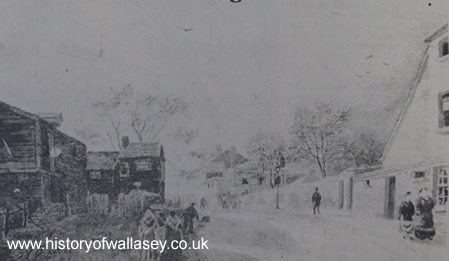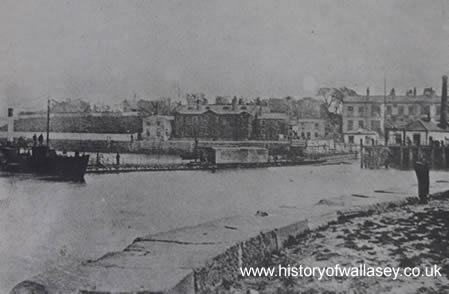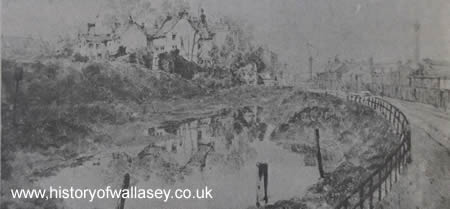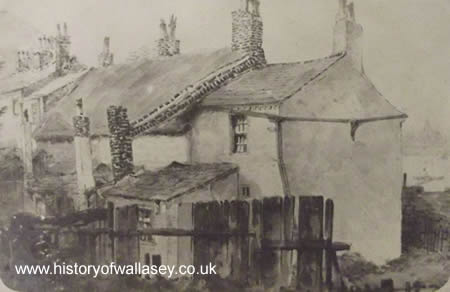Green and leafy, and with a lingering scent of hawthorne. That was how a poet sang of Seacombe some 120 years ago. And that was just as it was. Before the tower blocks of flats, before the road widening, and the changes that war and town planners brought about, the south end of town was very much the village. Right up to the 1920s it kept about it a character all its own. Now it has changed from a mainly shopping area to a residential area. Just a place like any other place.
There was a Secum Village in 1354, when a Samson family were the big local landowners. Probably there are records of the place going even further back.
There is evidence that in the 1500s and 1600s there was a herring curing industry here. There was a ferry – of sorts – as long as the fifteenth century.
Lands in Seacombe passed into various hands over the years. By the 1800s the area had become a place of substance.
In 1850 it was described as a country village. It had ‘lanes and leafy bowers’.
 |
View of Borough Road (then called Victoria Road), 1879. |
There was then one main street Victoria (now Borough) Road, two or three cross streets, a terrace or two scattered houses and some small industries.
There was John Goodwin’s pottery. It stood down by the docks just off Wheatland Lane, from 1852 until the 1870s. Its wares went round the world.
Shipyards came with the building of the docks in Wallasey Pool, just over a century ago. They were centred along the river front south of the ferry to Alfred Dock entrance.
Seacombe had a smalt works, the Peruvian Guano Works, and a small brewery.
If it were possible to take a stroll round the area as it was 120 or 130 years ago you would stumble on much that would enterprise.
You would find Catherine Terrace, in Ferryview Road. It was considered a rather special place.
It consisted of three houses built in the 1820s. Surrounding them was the poor tightly-packed property known as Mersey Street area. It was all swept away under a demolition order about 1930.
Catherine Terrace in the old days overlooked the end of the lengthy pleasure grounds which belonged to Stoke’s Seacombe Hotel. The elevated grounds followed the curved line of the river wall.
 |
Seacombe Ferry, 1870s, In the background, to the right, is Stokes Hotel |
Stoke’s was famous. It had an American bowling alley in its grounds, and cosy rustic arbours to sit in.
There was a summerhouse and a public clock. Opposite was the ferry landing stage.
All the ground on which the present clock tower, ferry buildings and the old former Seacombe Ferry Hotel is ‘made’ land. At one time the high water mark was along the line of Birkenhead Road.
Near the Seacombe end of Birkenhead Road was a gateway with the words ‘Marine Parade’ over it, carved on a painted board. This stood until the early 1920s.
 |
Seacombe Hotel on the left with the Marine Hotel to the centre |
Adjoining the Marine Hotel (better known as ‘Brassey’s' pub) which stood on Birkenhead Road there was up to about 120 years ago an irregular row of whitewashed brick cottages. There were masses of flowers in the gardens.
The oldest of the cottages was originally thatched and kept as an eating house by one Daniel Torney. This would seem to have been the original ferry house at Seacombe.
Belle Vue Road and all between that the what is now Borough Road was occupied by Belle Vue Tea and Pleasure Gardens.
Oakdale Road was a dale. North from the top of Borough Road fields stretched away towards Liscard.
Off Borough Road was the large and charming house of Dr. Isaac Byerley. Byerley Street now occupies the site.
There were avenues of trees. There were ponds and wooden gates.
Gorsedale Road was known as Cinder Lane, with green fields sloping down to Wallasey Pool.
 |
Birkenhead Road leading to Seacombe Ferry. The entrance to shipyards is to the right |
Running up from the Dock Road near Gorsey Lane was Creek Side, a name which recalled that Wallasey Pool was not always confined between dock walls.
At the turn of the century in the 1900s, the Seacombe area became one of the busiest and most heavily populated parts of the town. Its industries had grown. It had mills and factories. It had lots of little courts and alleys.
And it had Jimmy Wright. He was the headmaster of the Wesleyan School, in Brighton Street, and part and parcel of the old town.
There was the Irving Theatre (later Embassy Bingo) in Borough Road. It was big and plushy, and Seacombe was proud of it. Actor Sir Henry Irving laid its corner stone on October 11th, 1899. Seacombe made the occasion the excuse for a holiday. It remained the Irving until 1909, when it became The King’s. Then it was re- christened The Scala. Later it was called The Casino.
At 53 Demesne Street was Seacombe Cottage Hospital. Further along was the Abbotsford Hotel.
Off Brighton Street was the Vienna Hall (later the Marina Cinema). It was built by a Mr. Emmanuel Kopetzki, who came from the Austrian city.
 |
Old properties use to stand on the corner of Church Road and Borough Road East. The view is taken is from 1875. The houses were demolished to make way for Seacombe Railway Station. |
Over a century ago the tram cars rattled through a Seacombe of lively streets, gaslit at night. It may not have been the richest part of town but it was bursting with life.
Hop-scotch on the pavements. Street singers and Spanish onion men.
Set in the walls of most small streets were middens – communal dustbins emptied by horse drawn wagons.
West Seacombe Terrace (now Percy Road) had large houses occupied by the rather well-to-do. Ship owners and merchants from Liverpool had their homes there. Every house had its servant’s quarters. There were entrances for tradesmen.
Up to 100 years ago there was a clear view of Bidston Hill from the terrace. It was a walk from there to Oakdale, the Dock Road, and a path across the marsh to Bidston.
Westland House, at the top of the terrace, became the vicarage for St. Paul’s Church, built in 1846, with its 120 foot high spire a local landmark.
Old Seacombe began to break up just after World War One. Courts and alleys vanished in clouds of brick dust in the 1920s and 1930s.
The blitzes of World War Two brought toppling down most of what the demolition men and the clearance orders missed.
 |
Ferry View Road, 1912 |
The cobbles have gone, and the quaint old corners, and ‘Piggy Jone’s Field’.
Gone are the little cottages with the big gardens. Gone are the horses and carts. ‘The Blocks’, and Mersey Street.
Just 120 years ago a Mrs. Hannah Fisher, in a book of verse published in Australia, wrote
“Lanes of Seacombe, green and leafy,
Scenes no more that bless my sight.
Where no scent of hawthorne lingered
On the zephyr’s wing at night”.
Featured sites
- Non Gamstop Casinos
- Casino Not On Gamstop
- UK Casinos Not On Gamstop
- Non Gamstop Casinos UK
- Sites Not On Gamstop
- Sites Not On Gamstop
- Casinos Not On Gamstop
- Casinos Not On Gamstop
- Casinos Not On Gamstop
- Non Gamstop Casino UK
- Casinos Not On Gamstop
- Non Gamstop Casino
- UK Online Casinos Not On Gamstop
- UK Online Casinos Not On Gamstop
- Non Gamstop Casinos
- Casino Sites Not On Gamstop
- Casinos Not On Gamstop
- Casinos Not On Gamstop
- Best Betting Sites
- Casinos Not On Gamstop
- Gambling Sites Not On Gamstop
- Betting Sites That Are Not On Gamstop
- Non Gamstop Casinos UK
- UK Online Casinos Not On Gamstop